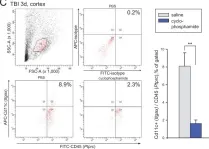Cellular quiescence is a reversible and tightly regulated stem cell function essential for healthy aging. However, the elements that control quiescence during aging remain poorly defined. Using melanocyte stem cells (McSCs), we find that stem cell quiescence is neither passive nor static. For example, gene expression profiling of the transition from proliferating melanoblasts to quiescent melanocyte stem cells reveals tissue-specific regulation of the immune checkpoint protein PD-L1. In vitro, quiescence assays demonstrate that PD-L1 expression is a physiological attribute of quiescence in this cell lineage and reinforces this cell state. In vivo, a subset of quiescent McSCs is marked by PD-L1. While the overall number of McSCs decreases with age, PD-L1+ McSCs appear resistant to depletion. This phenomenon coincides with an aged McSC pool that exhibits a deeper transcriptomic quiescence. We predict that quiescent PD-L1+ stem cells retained with age may serve as cellular targets for reactivation.
© 2024 The Author(s).
Product Citations: 128
In IScience on 18 October 2024 by Palmer, J. W., Villavicencio, K. M., et al.
-
Stem Cells and Developmental Biology
Epigenetic control of commensal induced Th2 Responses and Intestinal immunopathology
Preprint on BioRxiv : the Preprint Server for Biology on 30 August 2024 by Sangani, K. A., Parker, M. E., et al.
Summary Understanding the initiation of T-helper (Th)-2 immunity is crucial for addressing allergic diseases that have been linked to the commensal microbiota. However, Th2 responses are notably absent from known host-microbiota intestinal immune circuits. Notably, the commensal protist Tritrichomonas induces a transient innate ILC2 circuit rather than a chronic Th2 circuit. Canonical Th2 responses rely on the induction of IL-4 production by innate cells. This study shows that the absence of Tet2 , a DNA demethylase, reprograms naïve T cells to autonomously produce IL-4 upon T cell receptor stimulation, bypassing the need for IL-4 from innate cells for Th2 differentiation. Loss of this checkpoint induces chronic Th2 responses to Tritrichomonas , associated with IL-25-dependent barrier dysfunction and increased susceptibility to allergic pathology in response to dietary antigens. Sentence Summary Regulation of cell autonomous IL-4 in T cells is critical to prevent dysregulated Th2 immunity to commensals and predisposition to allergy.
-
Genetics
In Nature Communications on 22 August 2024 by Chung, K. P., Cheng, C. N., et al.
Type 2 alveolar epithelial (AT2) cells of the lung are fundamental in regulating alveolar inflammation in response to injury. Impaired mitochondrial long-chain fatty acid β-oxidation (mtLCFAO) in AT2 cells is assumed to aggravate alveolar inflammation in acute lung injury (ALI), yet the importance of mtLCFAO to AT2 cell function needs to be defined. Here we show that expression of carnitine palmitoyltransferase 1a (CPT1a), a mtLCFAO rate limiting enzyme, in AT2 cells is significantly decreased in acute respiratory distress syndrome (ARDS). In mice, Cpt1a deletion in AT2 cells impairs mtLCFAO without reducing ATP production and alters surfactant phospholipid abundance in the alveoli. Impairing mtLCFAO in AT2 cells via deleting either Cpt1a or Acadl (acyl-CoA dehydrogenase long chain) restricts alveolar inflammation in ALI by hindering the production of the neutrophilic chemokine CXCL2 from AT2 cells. This study thus highlights mtLCFAO as immunometabolism to injury in AT2 cells and suggests impaired mtLCFAO in AT2 cells as an anti-inflammatory response in ARDS.
© 2024. The Author(s).
-
Mus musculus (House mouse)
-
Cell Biology
-
Immunology and Microbiology
Epidermal growth factor augments the self-renewal capacity of aged hematopoietic stem cells.
In IScience on 19 July 2024 by Chang, V. Y., He, Y., et al.
Hematopoietic aging is associated with decreased hematopoietic stem cell (HSC) self-renewal capacity and myeloid skewing. We report that culture of bone marrow (BM) HSCs from aged mice with epidermal growth factor (EGF) suppressed myeloid skewing, increased multipotent colony formation, and increased HSC repopulation in primary and secondary transplantation assays. Mice transplanted with aged, EGF-treated HSCs displayed increased donor cell engraftment within BM HSCs and systemic administration of EGF to aged mice increased HSC self-renewal capacity in primary and secondary transplantation assays. Expression of a dominant negative EGFR in Scl/Tal1+ hematopoietic cells caused increased myeloid skewing and depletion of long term-HSCs in 15-month-old mice. EGF treatment decreased DNA damage in aged HSCs and shifted the transcriptome of aged HSCs from genes regulating cell death to genes involved in HSC self-renewal and DNA repair but had no effect on HSC senescence. These data suggest that EGFR signaling regulates the repopulating capacity of aged HSCs.
© 2024 The Authors.
-
Mus musculus (House mouse)
-
Stem Cells and Developmental Biology
In The Journal of Clinical Investigation on 11 June 2024 by Chung, Y. R., Awakoaiye, B., et al.
Viral vectors are being used for the treatment of cancer. Yet, their efficacy varies among tumors and their use poses challenges in immunosuppressed patients, underscoring the need for alternatives. We report striking antitumoral effects by a nonlytic viral vector based on attenuated lymphocytic choriomeningitis virus (r3LCMV). We show in multiple tumor models that injection of tumor-bearing mice with this vector results in improved tumor control and survival. Importantly, r3LCMV improved tumor control in immunodeficient Rag1-/- mice and MyD88-/- mice, suggesting that multiple pathways contributed to the antitumoral effects. The antitumoral effects of r3LCMV were also observed when this vector was administered several weeks before tumor challenges, suggesting the induction of trained immunity. Single-cell RNA sequencing analyses, antibody blockade experiments, and knockout models revealed a critical role for host-intrinsic IFN-I in the antitumoral efficacy of r3LCMV vectors. Collectively, these data demonstrate potent antitumoral effects by r3LCMV vectors and unveil multiple mechanisms underlying their antitumoral efficacy.
-
Mus musculus (House mouse)
-
Cancer Research
-
Immunology and Microbiology
In PLoS One on 26 August 2014 by Israelsson, C., Kylberg, A., et al.
Fig.6.C

-
FC/FACS
-
Mus musculus (House mouse)
Collected and cropped from PLoS One by CiteAb, provided under a CC-BY license
Image 1 of 1
